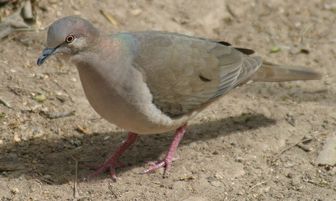White-tipped Dove
The White-tipped Dove inhabits scrub, woodland and forest. It builds a large stick nest in a tree and lays two white eggs. Incubation is about 14 days, and fledging another 15.

Original source: Transferred from en.wikipedia; transferred to Commons by User:Berichard using CommonsHelper.
Author: TimWhitehouse at en.wikipedia
Permission: GNU Free Documentation License
The White-tipped Dove is classified as Least Concern. Does not qualify for a more at risk category. Widespread and abundant taxa are included in this category.
The White-tipped Dove (Leptotila verreauxi) is a large New World tropical dove. It is a resident breeder from the southernmost Texas in the USA through Mexico and Central America south to western Peru and central Argentina. It also breeds on the offshore islands of northern South America, including Trinidad and Tobago and the Netherlands Antilles. Numerous subspecies exist; some of the more widespread are the nominate taxon, L. v. verreauxi, from Nicaragua to Venezuela, L. v. angelica from Texas and coastal Mexico, L. v. More
White-tipped Dove Range MapView dynamic map of eBird sightings Field MarksHelp - * AdultPopOutZoom In Adult * © Mary Tremaine / CLO Similar Species - * Mourning Dove is smaller, with a longer, pointed tail. * White-winged Dove has conspicuous white wing patches. More
The White-tipped Dove has an an enormous range reaching up to around 13 million square kilometers. This bird can be found throughout much of South America and Central America as well as areas of the Caribbean, including Argentina, Aruba, Belize, Bolivia, Brazil, Colombia, Costa Rica, Ecuador, El Salvador, French Guiana, Guatemala, Guyana, Honduras, Mexico, Netherlands Antilles, Nicaragua, Panama, Paraguay, Peru, Suriname, Trinidad and Tobago, United States, Uruguay, and Venezuela. More
White-tipped DoveThe White-tipped Dove (Leptotila verreauxi) is a large New World tropical dove. The scientific name of this bird commemorates the French naturalists Jules and Edouard Verreaux. The genus Leptotila was already described, but this particular species was named after Jules Verreaux who was an expert on exotic birds and was a principal at Maison Verreaux - the foremost supplier of natural history specimens in the early to mid 1800’s. The name is a latinized version of a French name Verreaux. More
This doesn't look like the White-tipped Doves I've seen here in S. Texas, USA. The back and wings in this image are much too dark and the body is much too light. The White-tipped Dove's bill is black and the feet are orange. Another clue is the image name, which is White-headed_dove.jpg. Sometimes the White-crowned Pigeon (Patagioenas leucocephala) is call the White-headed Dove but that's not it. The closest thing I could find with a quick search was the White-headed Pigeon (Columba leucomela) found in Australia. More
White-tipped Dove is usually seen singly or in pairs, and is rather wary. It builds a large stick nest in a tree and lays two white eggs. Incubation is about 14 days, and fledging another 15. The food of this species is mainly seeds obtained by foraging on the ground, but it will also take insects, including butterflies and moths. The call is a deep hollow ooo-wooooo. The scientific name of this bird commemorates the French naturalists Jules and Edouard Verreaux. More
White-tipped Dove, which gets its name from its white-tipped outer tail feathers, differs from Mourning Dove by size, tail length, plumage characters, and behavior. Note voice. More
● Similar species: White-tipped Dove: Mourning Dove has pink-gray forehead and throat, gray underparts, and long, pointed tail with white tips on all but central tail feathers. White-winged Dove has white crescents across wings. Flight Pattern Very swift direct flight with rapid wing beats. White-tipped Dove Breeding Male Body Illustration● Range & Habitat: White-tipped Dove: Resident in southern Texas. Also found in American tropics. Found in understories of dense, shady woodlands. More
The normal clutch size for the white-tipped dove is two white eggs. The eggs incubate about 14 days and both the male and female participate in the brooding process. Young eat a secretion, regurgitated by the parents, known as “pigeon milk” for three to five days. The adult birds supplement the secretion with an increasing mix of seeds until the young reach 12-14 days of age. At this time, young eat only regurgitated seeds and are ready to fledge. More
The White-tipped Dove has an approx. length of 28 cm (11 in) and a weight of 155 g (5½ oz). Adult birds of most races have a grey tinge from the crown to the nape, a pale grey or whitish forehead and a whitish throat. The eye-ring is typically red in most of its range, but blue in most of the Amazon and northern South America. More
White-tipped Dove in North and Central America. The White-tipped Dove, also known as the White-fronted Dove, is a common Neotropical species that reaches the northern limit of its range in southern Texas. Despite its extensive range in South America, Central America, Mexico, and north into southern Texas, little information is available on this species anywhere in its range. More
The White-tipped Dove is grey-brown above, white below and has a white band at the tip of the tail. It More
, White-tipped Dove is limited to the lower Rio Grande Valley. More
White-tipped Dove and chick nesting in Escazu at the end of March. Commonly known in Spanish as Paloma Montarraz Comun, Yuré, or Coliblanca. nextlast first previous White-tipped Dove Size: Full size: 2048x1536 Terms of Use: The only condition we place on the use of our photographs is to place a link back to us somewhere in your site. Place a link like: "Courtesy of CostaRicaPhotos. More
White-tipped Dove, adult on ground More

Original source: Cl
Author: Cl
Permission: Some rights reserved
Family : Columbidae
Genus : Leptotila
Species : verreauxi
Authority : Bonaparte, 1855
